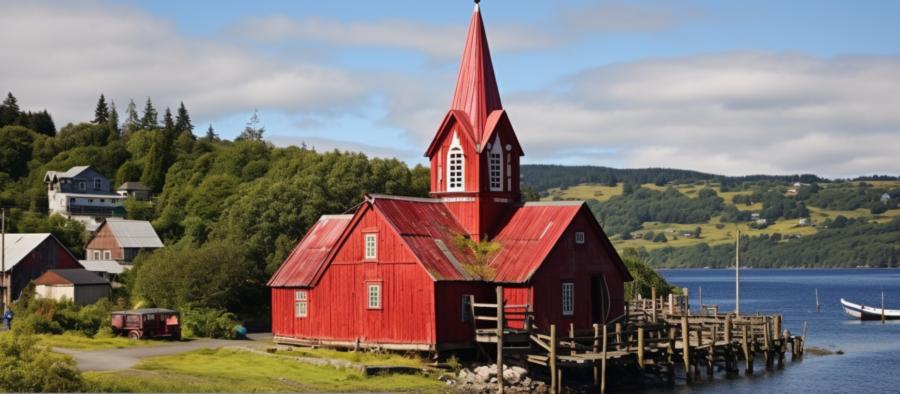Chiloe Island: Chile's Mythical Land of Wooden Churches

A Magical Journey to Chile's Isla Grande
Ah, Chiloe Island, Isla Grande de Chiloe, that remote and almost mythical archipelago in southern Chile. Clinging to the skirts of Chile's Pacific coastline like an estranged cousin, Chiloe is home to a unique cultural landscape where the mundane meets the supernatural. As the ferry from Pargua chugs along through the Chacao Channel, one can't help but feel a profound sense of excitement, and perhaps a touch of trepidation, as the island comes into view. Here, folklore and reality intertwine in a tapestry of whimsy and mysticism, and wooden churches stand as enduring testaments to the island's rich history and tradition.All Aboard the Ferry: Gateway to Chiloe Island
The journey to Chiloe begins with a voyage across the Chacao Channel, departing from the mainland port of Pargua. As the ferry cuts through the chilly waters, one can catch glimpses of sea lions basking on rocky outcrops and seabirds gliding along the crests of the waves. The crossing takes approximately 30 minutes, which is just enough time to ponder the island's enigmatic allure and prepare oneself for the cultural and architectural wonders that lie ahead.A Land of Myth and Legend
Upon setting foot on Chiloe, the curious traveler will soon discover that the island's charm lies not only in its picturesque landscapes and unique fauna but also in its legendary tales and mythical creatures. The island is steeped in folklore, populated by an array of fanciful beings that blur the line between reality and fantasy. Here, one can hear whispers of the Trauco, a lecherous forest-dwelling gnome said to seduce young women, and the Pincoya, a mermaid-like sea spirit who is believed to protect fishermen and ensure bountiful catches.A journey through Chiloe is not complete without delving into the island's beguiling mythology, which can be experienced through the numerous local festivals, markets, and art galleries that showcase the island's rich cultural heritage. Whether it's the minga, a traditional community gathering where locals collaborate to move a house on wooden logs, or the vibrant Festival Costumbrista, which celebrates the island's folkloric music and dance, Chiloe offers ample opportunities to immerse oneself in its colorful traditions and enchanting tales.
The Legacy of Chiloe's Wooden Churches
Scattered throughout the island, Chiloe's wooden churches are a testament to the resilience of its people and the influence of the Jesuit missionaries who brought Christianity to the region in the 17th century. Built almost entirely of timber, these humble yet striking structures are a fascinating mix of European and indigenous architectural styles. Today, 16 of these churches have been designated UNESCO World Heritage Sites, drawing visitors from around the world to marvel at their unique beauty and craftsmanship.Perhaps the most famous of Chiloe's wooden churches is the Church of San Francisco in Castro, the island's capital. With its distinctive yellow and purple façade, the church towers over the surrounding buildings, casting a benevolent gaze upon the colorful stilt houses that line the waterfront below. Venture inside, and you'll find an intricate display of woodwork, gilded altars, and religious art, all bathed in a divine light that filters through the church's stained glass windows.
Exploring Chiloe's Natural Wonders
Beyond the wooden churches and mythical tales, Chiloe boasts a captivating natural landscape that beckons the intrepid traveler. The island's rugged coastline, vast wetlands, and verdant forests are home to a diverse array of flora and fauna, including some species found nowhere else on Earth. Chiloe National Park, in particular, offers a chance to explore this untamed wilderness and encounter its most elusive inhabitants, such as the Chilote fox and the rare pudú, the world's smallest deer.For those who prefer their nature with a side of solitude, the smaller islands of the archipelago offer a more secluded experience. A trip to the tranquil island of Quinchao, for example, rewards visitors with unspoiled beaches, enchanting forests, and an unrivaled sense of serenity. Here, the only sounds that punctuate the silence are the gentle rustling of leaves, the lilting calls of birdsong, and the rhythmic lapping of waves on the shore.
A Farewell to Chiloe: The Journey's End
As the ferry pulls away from Chiloe Island, bound once more for the mainland, one can't help but feel a pang of sadness at the prospect of leaving this magical land behind. The memories of wooden churches, mythical creatures, and untamed nature will linger in the mind, calling the traveler back to Chiloe's enchanting shores time and time again. For, as the locals know all too well, once the spell of Chiloe has been cast, it is a spell that is not easily broken.Article kindly provided by myfavouritehols.com
Latest Articles
- How to Plan Around Peak Congestion Days for Mountain Trips
- Mapping Your First Mountain Resort Loop Without Losing Your Sanity
- How Pro Kitchen Renovations Quietly Increase Booking Confidence in Self-Catering Stays
- Discover a City's Real Character From the Backseat
- How to Make Airport Layovers Surprisingly Productive
- From HVAC to ROI: the Hidden Economics of Sustainable Hotel Design
- How to Plan Your Day Tours to Minimize Crowds and Maximize Serendipity
- From Tourist to Observer: How to Photograph a City Like a Local
- Seasonal Shifts in Abandoned Turkish Valleys Reveal Clues About Heritage Site Decay
- Mastering Group Travel Planning for Events in Fort Lauderdale
- Beyond the Beach Bus: Hidden Palm Beach Spots Worth the Group Ride
- Chrono-Travel and Time Zone Acrobatics on a Coach
- Hidden Miami Charter Bus Routes to Secret Beaches, Local Food Gems, and Underrated Attractions
- More Than Just Ice - Unexpected Events at Amerant Bank Arena
- Madrid's Strangest Museums and Attractions You Never Knew Existed
- Disaster-Proof Rentals: A Flood-Resilient Guide for Holiday Homeowners
- Following the Footsteps of Filmmakers: Morocco's Iconic Movie Locations You Can Visit
- Hidden Gems Along Morocco's Coastline
- Tastes of Miami: Culinary Tours for the Global Foodie
- Milwaukee's Hidden Green Gems: Nature's Best Kept Secrets

